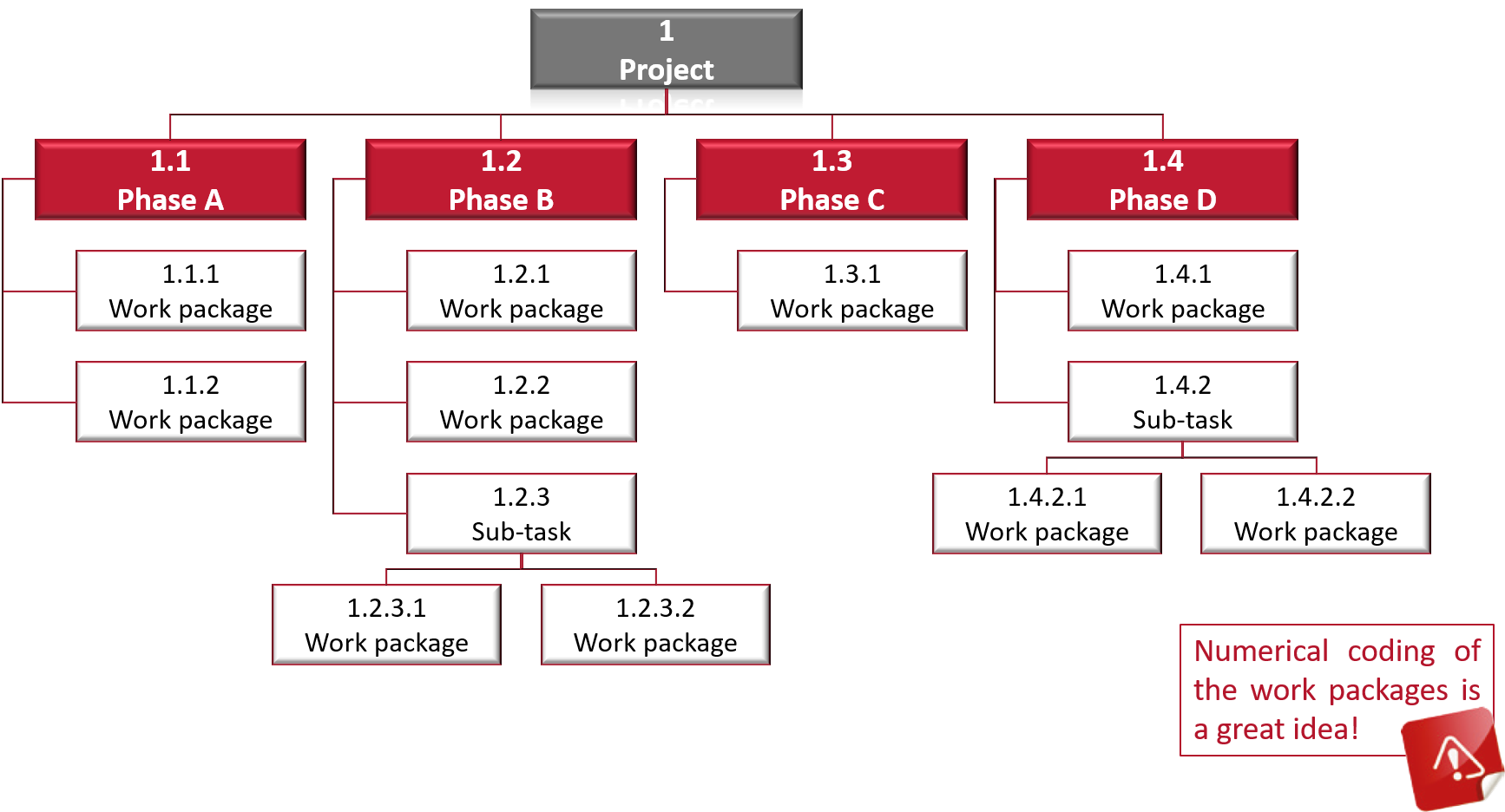Chapter 10 - Creation of the Work Breakdown Structure (WBS)¶
Part 2¶
Creation of the work breakdown structure¶
Conscientious people often write a checklist containing all the tasks to be performed before any major personal project (e.g. a holiday, a family celebration). In the same way, project managers and their teams should prepare a similar list at the earliest opportunity - in other words, a work breakdown structure (WBS) containing the activities that a project involves. In contrast to personal checklists, a WBS generally consists of several levels, i.e. it has a hierarchical structure. There are a number of rules to be observed when developing a WBS. To avoid that important sub-tasks are overlooked, mostly this is the centrepiece of many extensive projects.
→ Project structuring is the process of breaking down a project into work units and tasks.
→ WBS is a chart or table showing the structure of the project and a systematic answer to the question: "What work does our project involve?".
→ It is a hierarchical representation of the project, broken down into several levels.
→ The structure can be based around objects, sub-tasks or business units.
The WBS is a useful tool for organising related work packages and the overall project, for uncovering ambiguities in the target definition or for preparing work packages for external processing.
Attention
The WBS does not show, in which logical order the tasks have to be carried out!
Indications that it is necessary to create a WBS and define work packages:
- Overlapping, cost or time-intensive phases in the project
- Concerns that it may not be possible to implement the project
- Expected, possibly substantial risks
It can be differentiated between four kinds of WBS:
- Phase-oriented
- Function-oriented
- Object-oriented
- Mixture of all three
To create the WBS, a team workshop can be done. The question for this workshop is
Remember that the answers to the question do not initially provide any information about expected costs or time required. The WBS does not contain project objectives nor process objectives. This information is obtained on the basis of the defined work packages, which will be dealt with later on.
In the first step, every team member individually writes down his or her answers, ensuring that they don't just write keywords, but phrases (wrong: "list", right: "create list"). This is a classic creativity technique called brainwriting. The first step of the process can also be supported by mind mapping or similar methods. All answers are then written on Metaplan cards.
Then a moderator is nominated. He or she has to compile the individual team members' answers into clusters and define headings for each cluster. When all the topics have been clustered, another check is made to see whether any more headings or tasks will be necessary to ensure completeness.
The now defined work packages are delegated to the team members for precise definition.
Information
In particularly critical projects, it can be helpful to create WBSs with different emphases (phase, function or object-oriented) to close any gaps that may exist.
For the sake of completeness, the date of WBS creation and the participants should be noted. If possible, involve staff who can contribute knowledge and experience i.e. competence from their specialist field.
Here is an example how a phase-oriented WBS could look like:

The WBS can be subdivided as often as required, but should not have too many levels - this increases the risk of becoming entangled. A project can consist of different sub-tasks and work packages, whereby the individual WPs are the smallest unit of a WBS.
It is also possible to create a standard WBS
This may avoid creating a completely new WBS every time and it also serves as a kind of checklist, so that for new projects no essential parts or work packages are left out.
How the story ends…¶
When Dr. Rogers explained the procedure for creating a work breakdown structure to his team, Chris Feldmann comments, "If we do it like this, we can't be creative as a team and, apart from that, it's an unnecessary waste of time." Grace Holmes immediately contradicts him. "That's not true! It's a common misunderstanding that chaos fosters creativity. Even Goethe knew how important emotional control is and that simply isn't possible in a chaotic situation." "Yes, you need time and organisation to produce ideas", confirms William Rose. "I think it's a good idea! Let's write all the answers to the question of what we have to do to implement the project on pieces of paper. It'll give us the chance to collect our thoughts." "Good idea. And when we've got all the ideas together, we can start organising and structuring the project and give it a proper schedule", adds Grace.